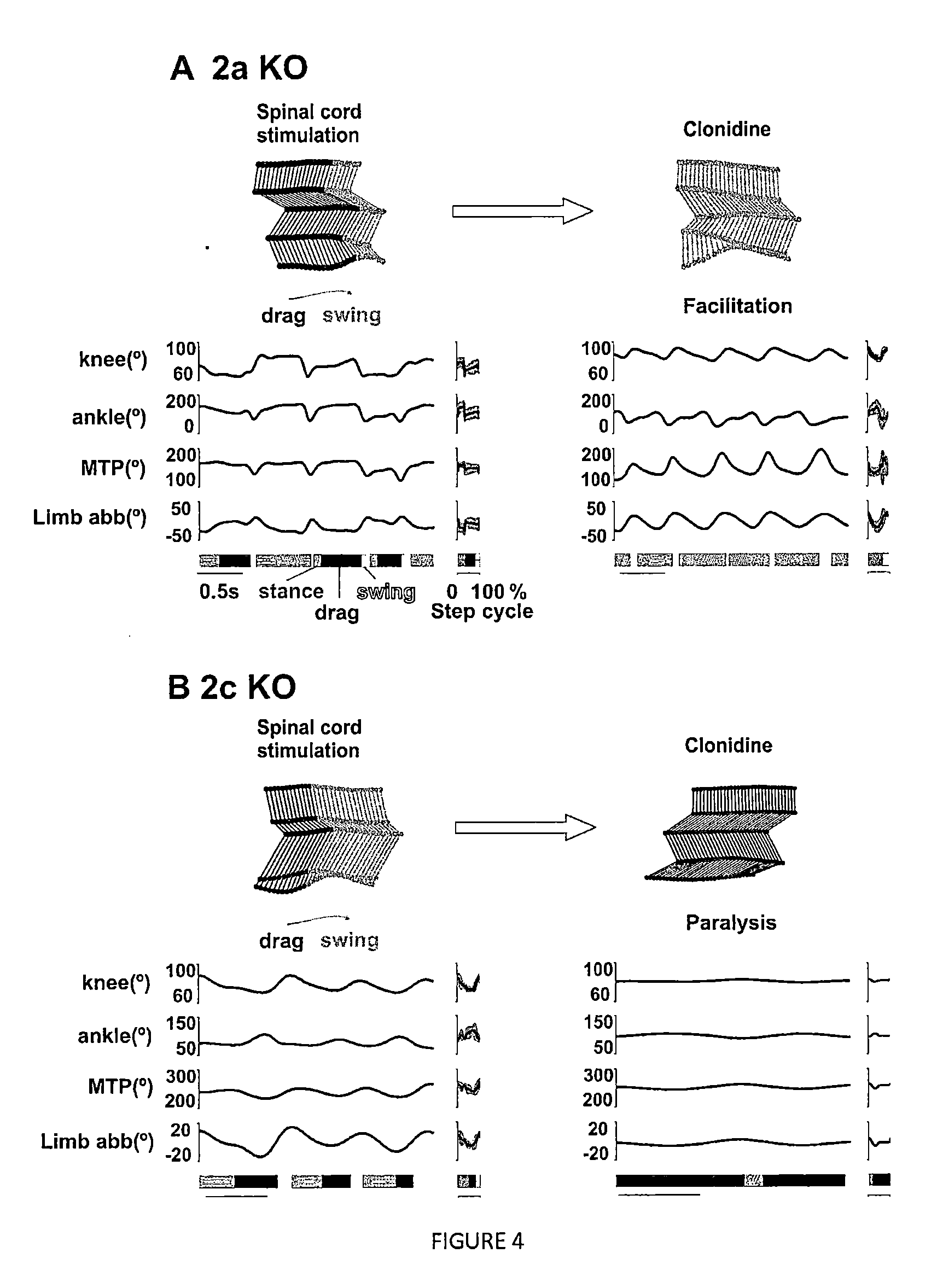Pharmacological stimulation to facilitate and restore standing and walking functions in spinal cord motor disorders
- Summary
- Abstract
- Description
- Claims
- Application Information
AI Technical Summary
Benefits of technology
Problems solved by technology
Method used
Image
Examples
example 1
Alpha2 Receptor Subtypes Specific Modulation of Stepping Patterns Enabled by EES in Spinal Rats
[0118]Experiments were conducted on adult animals that received a complete midthoracic (T7) spinal cord transection which permanently removed all supraspinal input below the level of the lesion. To reach stable levels of excitability in the spinal networks to facilitate stepping electrically (Lavrov et al., 2008), the rats were allowed to recover for 5 weeks after lesion before initiating experimental recordings (FIG. 1A). At this time point and during the subsequent 4 weeks after lesion, the rats showed no (FIG. 1B) spontaneous hindlimb stepping when supported in a bipedal posture on a moving treadmill belt (13 cm / s) (FIG. 1A). In contrast, continuous (40 Hz, 0.2 ms, 50-200 μA) EES applied dorsally over the S1 and L2 spinal segments generated continuous hindlimb locomotion on the treadmill in all rats tested (FIGS. 1C and 2A).
[0119]A marked facilitation of locomotion by the α2 adrenergic ...
example 2
Blocking of the α2a and α2c Noradrenergic Receptors in Knockout (KO) Mice
[0123]To validate the results obtained with a pharmacological blocking of the α2A and α2C noradrenergic receptors we performed supplementary experiments in knockout (KO) mice. Electrical epidural stimulation was applied as described in Example 1. Two groups of spinal mice lacking α2a or α2c receptors were injected with clonidine, a non specific agonist of the alpha 2 receptor subtypes (FIG. 4). In the α2a KO mice, clonidine injection triggered a facilitation of the locomotor function, an increase of the movement magnitudes of the hindlimb joints as well as an improvement of locomotor stability (FIG. 4A). Conversely, clonidine injection in α2c KO mice resulted in a significant blocking of the locomotor abilities of the animal (FIG. 4B).
[0124]Alpha 2 receptors subtypes a and c are predominantly inhibitory. The α2a receptor subtype is predominantly expressed on myelinated proprioceptive and cutaneous afferent neur...
example 3
Alpha2c Receptor Subtype Specific Stimulation Facilitates Stepping Patterns Enabled by EES in Spinal Rats
[0127]Experiments were conducted on adult animals that received a complete midthoracic (T7) spinal cord transection which permanently removed all supraspinal input below the level of the lesion. To reach stable levels of excitability in the spinal networks to facilitate stepping electrically (Lavrov et al., 2008), the rats were allowed to recover for 2 weeks after lesion before initiating experimental recordings (FIG. 6). At this time point, the rats showed no spontaneous hindlimb stepping when supported in a bipedal posture on a moving treadmill belt (13 cm / s). In contrast, continuous (40 Hz, 0.2 ms, 50-200 μA) EES applied dorsally over the S1 and L2 spinal segments generated continuous hindlimb locomotion on the treadmill in all rats tested (FIG. 6).
[0128]The α2c agonist, a 2-amino-oxazoline derivative of formula (I) (C10N2H10OF2, 200 umol / kg), significantly improved locomotion...
PUM
 Login to View More
Login to View More Abstract
Description
Claims
Application Information
 Login to View More
Login to View More - R&D
- Intellectual Property
- Life Sciences
- Materials
- Tech Scout
- Unparalleled Data Quality
- Higher Quality Content
- 60% Fewer Hallucinations
Browse by: Latest US Patents, China's latest patents, Technical Efficacy Thesaurus, Application Domain, Technology Topic, Popular Technical Reports.
© 2025 PatSnap. All rights reserved.Legal|Privacy policy|Modern Slavery Act Transparency Statement|Sitemap|About US| Contact US: help@patsnap.com



